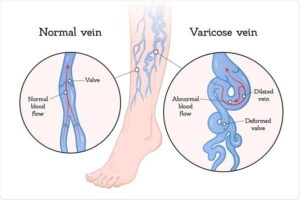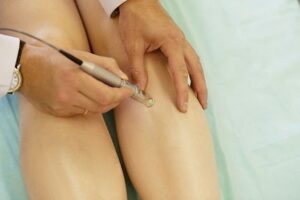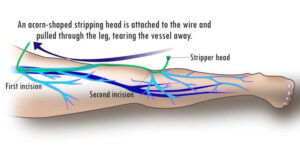Call: (647) 352–3233 | Fax: (416) 630–6415
Veins/EVLT
WHAT ARE VARICOSE VEINS?
Varicose veins are superficial, enlarged and twisted veins near the surface of the skin and occur when weak or defective valves allow blood to flow backward or stagnate within the vein. Varicose veins can appear anywhere in the body, but are more common on the thighs and calves. Varicose veins typically appear swollen and raised and have a bluish-purple or red color.
Varicose veins are caused by increased blood pressure in the veins. The blood moves towards the heart by one-way valves in the veins. When the valves become weakened or damaged, blood can collect in the veins. This causes the veins to become enlarged. Sitting or standing for long periods can cause blood to pool in the leg veins, increasing the pressure within the veins. The veins can stretch from the increased pressure. This may weaken the walls of the veins and damage the valves.


WHAT IS THE TREATMENT OPTIONS FOR VARICOSE VEINS?
There are two measures you can implement to decrease the discomfort that varicose veins cause and also potentially slow down their development.
-
ENDOVENOUS LASER TREATMENT (EVLT)
Endovenous laser varicose vein surgery is a procedure that uses heat from a laser to reduce varicose veins. Varicose veins are swollen, bulging veins that often occur on the thighs or calves. A laser is a device that sends a thin beam of radiation in the form of light.
Laser Therapy closes and shrinks the varicose veins and causes scar tissue within the vessel. This seals off the vein. Blood then flows through other nearby veins instead.

BEFORE AND AFTER

-
VENOUS LIGATION

Vein Ligation is an effective treatment method for varicose vein removal which is generally done on large varicose veins. The procedure involves removing the affected vein all at once, pulling the vein from the top of the leg through an incision at the knee or the ankle. It is used to remove a damaged vein and prevent complications of venous damage. If several valves in a vein and the vein itself are heavily damaged, the vein or the diseased part of the vein is removed. An incision is made below the vein, a flexible instrument is threaded up the vein to the first incision, and the vein is grasped and removed.
During this surgery, one or more very small incisions are made over the damaged veins, and the vein is tied off. If the ligation cuts off a faulty valve and the vein and valves below the faulty valve are healthy, the vein may be left in place to continue circulating blood through other veins that still have valves that work well.